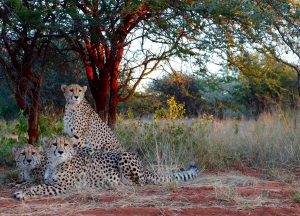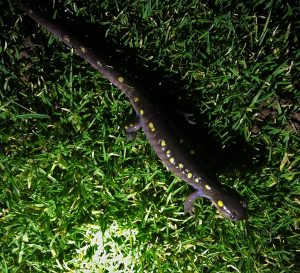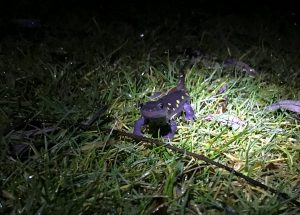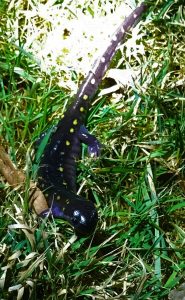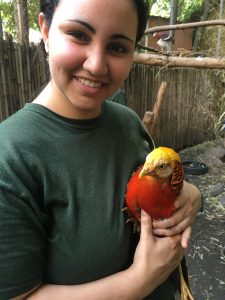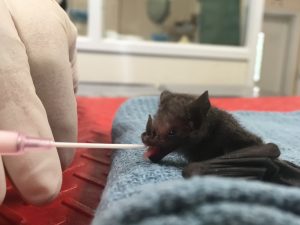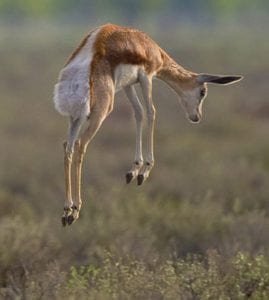
A young springbok prancing in the air, a behavior known as “pronking.” Photo via Wikimedia Commons, licensed under CC BY-SA 3.0.
A one-day-old springbok rises on his gangly legs — the shriveled umbilical cord still dangling from his ventrum — and begins to boing around his new surroundings. There is plenty to discover in the vast African bushveld, which he proceeds to do with reckless abandon.
Suddenly, a group of jackals saunters from behind an acacia tree and one of them seizes the “bokkie” by the neck. Within seconds, a game reserve employee dashes out of his safari vehicle to shoo away the jackals, gingerly picks up the injured springbok, and races to the wildlife clinic. Thankfully, no puncture wounds are detected, only bruising — the bokkie is later returned to the original site. The veterinarian waits from afar, hoping the youngster will rejoin his springbok herd.
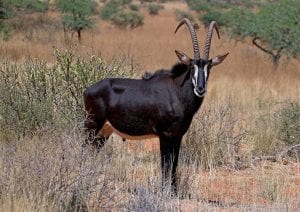
Adult male sable antelope (Hippotragus niger). Photo via Wikimedia Commons, licensed under CC BY-SA 4.0.
A month later, an adult male sable is seen hobbling on three legs due to a severe hoof infection. Darting supplies and medications are loaded onto a helicopter, from which the sable is safely anesthetized. After sedation is achieved, the hoof is examined and subsequently treated with saline flush and antibiotics. A reversal drug is then injected into the thigh muscle, upon which personnel are instructed to vacate the premises expediently. Meanwhile, the veterinarian remains on-site to verify the antelope’s full recovery.
Clearly, there is never a dull day in wildlife medicine. As an aspiring wildlife veterinarian who plans to pursue conservation medicine, I have frequently encountered this bioethical issue in both my academic studies and fieldwork. The aforementioned circumstances were experiences I witnessed during my summer in Namibia, where I was conducting research and shadowing the resident veterinarian on a wildlife reserve. Although these individual scenarios involved many factors worth analyzing, the veterinarian plays a prominent role in each situation, often deferred to for coordinating the remedial actions taken and their outcomes.
The aftermath of the above scenarios: the sable gradually improved post-treatment, whereas the springbokkie was never seen again — and thus, presumed dead.
That begs the question: Was it right for the employee to painstakingly pluck the baby springbok from his herd after being attacked by jackals? Were his actions compassionate or officious? Although the infant was promptly returned, it was possible the bokkie was rejected from his herd since the human handling had now covered him in foreign scent. After failing to be adopted back into the group, he was left vulnerable to the pesky jackals once more.
As health care professionals, veterinarians are uniquely positioned to address complex ethical issues involving human, animal, and ecosystem health — a concept aptly known as “One Health.” This initiative governs the core of conservation medicine and reflects the interrelationship and transdisciplinary approach needed to ultimately ensure the wellbeing of all.
The history of human-wildlife relations has experienced some challenges and backlash, but handling these interactions involves balancing valid concerns, prioritizing values, and adopting a hybrid perspective. We regularly wrestle with whether our actions are restorative or destructive, and reflect on a track record of gratifying wins and unsavory losses to learn from. Given our substantial roles in the fate of conservation, it is imperative to debate the significance of interventional efforts and whether they can be rationalized.
While the veterinary profession certainly paints a noble picture of treating injured and sick animals, conducting mass rescues, and mitigating human-wildlife conflict, the interventional aspect entailed in all these tasks suggest, to some, the controversial idea of “playing God.” Are the measures taken regarded as dutiful obligation or self-righteous interference?
On a more abstract level, such apotheosis is inevitable for any professional practicing contemporary medicine. However, the hubris of playing God is arguably heavier for veterinarians since more stakeholders fall within their jurisdiction. As an arbiter for animals, humans, and the environment, veterinarians are constantly confronted with clinical decisions involving life and death and must calculate the associated risks and benefits for multiple constituents. Tampering with the system may result in inadvertent consequences. Conversely, just because resources are available does not necessarily mean they should be used.
Though many have applauded scientific achievements such as GMOs, assisted reproductive technologies, and instrumental surveillance, others have perceived these fields as an exercise of human dominance. The idea of wildlife intervention engenders similarly conflicting sentiments. When physicians and scientists employ these seemingly “unnatural” methods, public fear arises around their potential negative — albeit unintended — consequences. Such discomfort may reflect an underlying mistrust of science and technology in favor of a powerfully unpredictable force of nature as the ultimate source of authority. When working on a free-ranging wildlife reserve that actively promotes conservation, there are various instances in which human intervention is utilized, sparking discussion of the decision-making principles that are applied and the degree of success achieved.
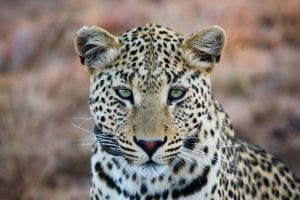 On one hand, the “Circle of Life” argument is commonly cited against wildlife intervention. Such critics support a laissez-faire policy that enables Mother Nature to take her course. Any meddling on the veterinarian’s part would thereby violate this principle. Despite one’s desire to aid the patient and provide necessary care for its survival, that may interfere with the operative principle of natural selection. In retrospect, with the bokkie case, a passive approach may have been best. Simply put, there are predator species and prey species; animals must eat to survive, and we cannot disrupt this instinct.
On one hand, the “Circle of Life” argument is commonly cited against wildlife intervention. Such critics support a laissez-faire policy that enables Mother Nature to take her course. Any meddling on the veterinarian’s part would thereby violate this principle. Despite one’s desire to aid the patient and provide necessary care for its survival, that may interfere with the operative principle of natural selection. In retrospect, with the bokkie case, a passive approach may have been best. Simply put, there are predator species and prey species; animals must eat to survive, and we cannot disrupt this instinct.
However, the “Circle of Life” argument fails to extend to veterinary work conducted with domestic pets — namely, preventative medicine. For example, routine vaccination protocols that keep our companion animals healthy are also employed in wild animals to prevent the spread of infectious diseases. If an emerging disease threatens an epidemiological crisis — especially if the pathogen is zoonotic, i.e. can be transmitted between animals and people — this must be addressed on a population level to prevent a mass mortality event.
Generally, the guideline regarding wildlife intervention is to act when the problem presented is due to human impact. Whether it’s gunshot wounds, lead toxicity, or hit-by-car cases, we are obligated to treat accordingly. We bear a responsibility to rectify anthropogenic consequences wrought on wildlife, simply because we caused them. Moreover, other factors warrant intervention, particularly if there is monetary value attached to a certain animal or species in need of saving. In fact, this factor supported the decision to intervene with the adult sable, who was one of three males on the entire reserve. For the purposes of his health and tourism value, treating this sable was deemed permissible.
As stewards and advocates of nature, we understand the precautionary principle of playing God, its inextricable social and ethical implications, and the requisite, evidence-based risk management of any impending decisions. While there is no absolutism with these difficult situations and exceptions can occasionally be made, moral reflection, consideration of all stakeholders, and development of our own self-knowledge may help us navigate this complex terrain.
This post is written by Elvina Yau and was originally published on Mongabay on October 8, 2018.
ABOUT THE AUTHOR:
 Elvina Yau, class of 2020, is a veterinary student from Long Island, New York. She graduated from the University of Pennsylvania in 2016 with a degree in Behavioral Neuroscience and double minor in Creative Writing & Biology. Elvina aspires to split her time between practicing Companion Animal Medicine in the U.S. and contributing to conservation efforts abroad both as a clinician and freelance photojournalist.
Elvina Yau, class of 2020, is a veterinary student from Long Island, New York. She graduated from the University of Pennsylvania in 2016 with a degree in Behavioral Neuroscience and double minor in Creative Writing & Biology. Elvina aspires to split her time between practicing Companion Animal Medicine in the U.S. and contributing to conservation efforts abroad both as a clinician and freelance photojournalist.



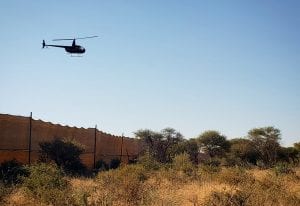
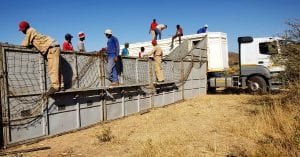
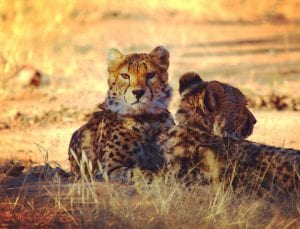
 Greetings from Otjiwarongo, Namibia! My name is Elvina Yau and I am a rising 3
Greetings from Otjiwarongo, Namibia! My name is Elvina Yau and I am a rising 3